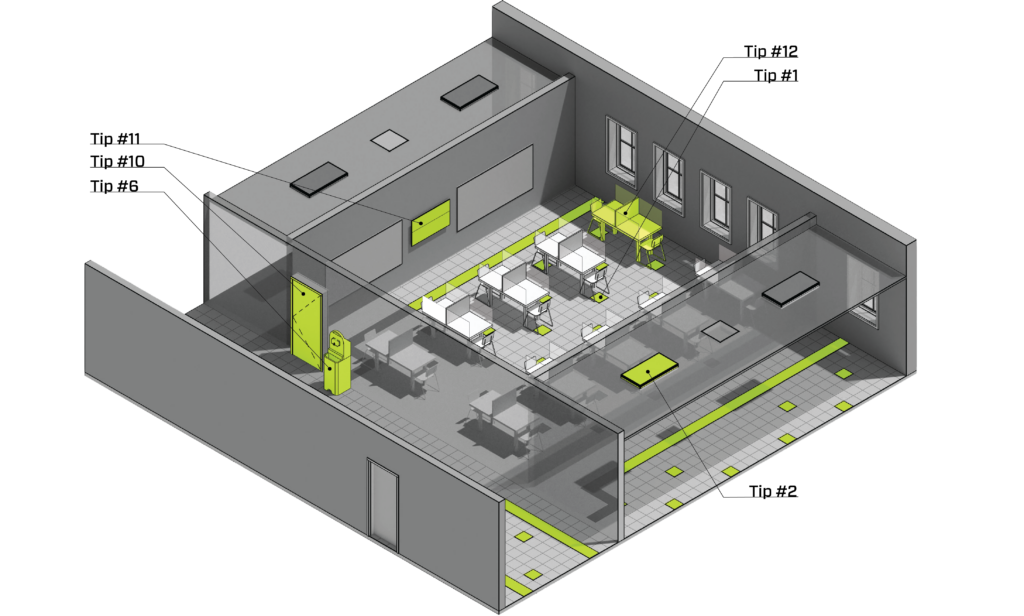There’s a lot to consider as schools prepare for the upcoming school year. That’s why we’re sharing 12 tips on how to prep your classrooms (if your school district is ready to reopen).
Whether you use some or all of the tips below, be sure to check with state and local health officials and other partners to determine the most appropriate actions for your school.


Tip #1: Simple Visual Cues for 6′ Social Distancing
You can buy vinyl floor signage to help remind students to keep a 6 feet distance from peers in the hallway, classroom or other spaces. But in a pinch, use the extra colored tiles (or carpet squares if you have carpet) that you already have in storage. Properly install them 6 feet apart and voila! Quick, affordable, visual cues.
Tip #2: Consider Germicidal UV (GUV) Lighting for Afterhours
GUV Disinfection Lighting can be used to help disinfect surfaces and spaces while the building is unoccupied overnight.
Tip #3: Open the Windows
When it’s nice out, open operable windows to increase ventilation and circulation of outdoor air in the classroom.
Tip #4: Invest in Acrylic Desk Shields
Install clear, acrylic desk shields to minimize the spread of airborne droplets from coughing and sneezing.
Tip #5: Serve Lunch in the Classroom
Consider in-class food service to limit large gatherings of students. Reserve adequate aisle space in your classroom for food delivery.
Tip #6: Set Up Sanitizing Stations
Add a sanitizing station in each classroom and encourage students to wash hands frequently. This could be as simple as a hand sanitizer dispenser stand, a temporary, portable hand wash station, or a fixed hand wash sink.
Tip #7: Print and Post Educational Flyers
Post signs promoting hand-washing, desk sanitizing, and other protective measures students can take to stay healthy and stop the spread.
Tip #8: Have Storage for Cleaning Supplies
Make sure each classroom has adequate, accessible storage for supplies like soap, hand sanitizer, paper towels, tissues, disinfectants, and face coverings.
Tip #9: Have Storage for Personal Items
Provide storage for personal items too. Assigned cubbies, bins, and other containers can keep backpacks, coats, and other belongings organized and isolated, so these items are less likely to be touched by others throughout the day. Having dedicated learning aids, books, devices, etc. per student also limits the use of shared objects and can help stop the spread.
Tip #10: Provide Temperature Checks
It’s a good idea to check temperatures as students enter the building or classroom. That way, you can identify symptomatic students before exposing them to others.
Tip #11: Lean on Technology
Use or install technology in the classroom that allows for E-learning and virtual meetings. These options provide students with underlying conditions, quarantined students, and symptomatic students the tools to participate and collaborate with their peers. This also provides opportunities to connect with other classes, introduce exterior instructors, and conduct virtual field trips while limiting the amount of exposure to others.
Tip #12: Prep Shared Desks
Many classrooms use shared desks instead of the traditional single-student set up. If you have shared desks in your classroom, be sure to provide 6 foot spacing between seats, assign seats so the same students are always paired together, and consider adding clear, acrylic desk shields to help reduce exposure.
More About Paragon Architecture
We partner with schools, municipalities, and businesses throughout Missouri to design buildings that support student learning, energize communities, and inspire employees. Our architects and interior designers are passionate project managers, ready to advocate your vision from the first sketch to your final phone call—and beyond.
We call our collaborative process The Paragon Approach™. Think of our team as your architectural Sherpas—highly skilled and experienced guides you can count on every step of the way. Ready to learn more? Contact our team.



